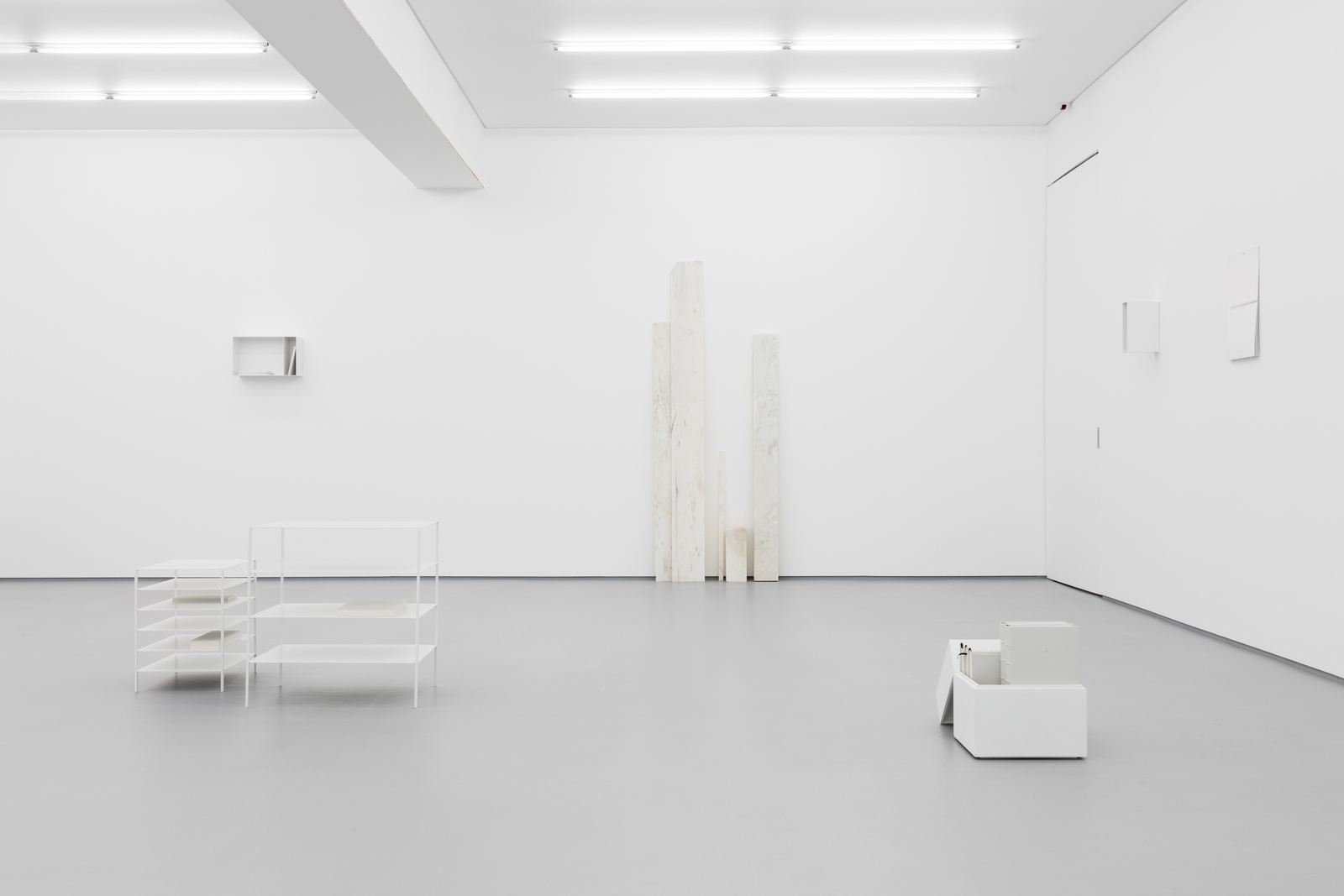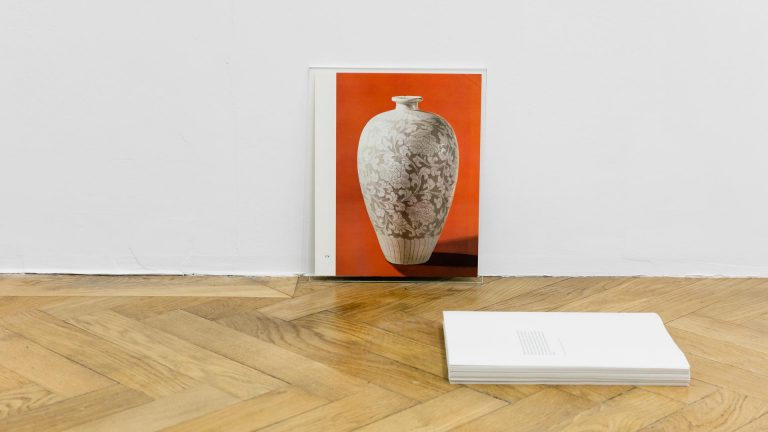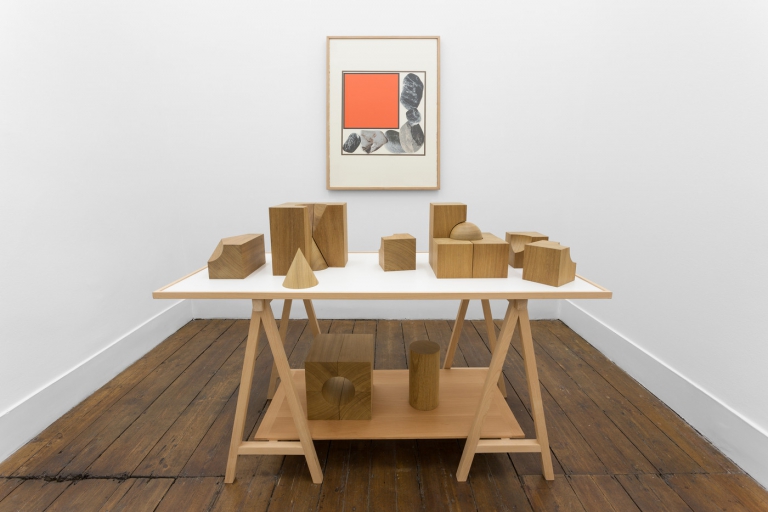Artist: Daniel Gustav Cramer
Exhibition title: Fourteen Works
Venue: Galeria Vera Cortês, Lisbon, Portugal
Date: May 5 – June 24, 2016
Photography: Bruno Lopes, images copyright and courtesy of the artist and Galeria Vera Cortês
“Every moment, inasmuch as it is a passage from rest to rest, is absolutely indivisible.”
Henri Bergson, Matter and Memory, 1896
For his fourth exhibition at Galeria Vera Cortês (the first in the new space which opened last Fall), Daniel Gustav Cramer (1975, Neuss, Germany), brings together a group of works that are in dialogue with each other through the simple intertwining of ideas and that meet mostly in associations that are made by whomever enters the space and experiences the exhibition. Some of the works are almost invisible within their physical existence; this happens both by their waning presence, on the one hand, and the materiality they carry, on the other, ultimately alluding to an intimate narrative of the exhibition. Rainbow is a striking yet subtle example of this – an application of nine layers of paint of different colours onto a wall of the exhibition space in an order defined by the artist, the last colour of the set being white. The only traces unveiled of these coloured coatings subtly emerge on the sides of the wall.
Cramer, whose works often suggest a subjective perception of the world surrounding us, brings to this exhibition a combination of thoughts represented through a variety of media – from his intimate artist books to site-specific installations such as Empty Room, where for the duration of the exhibition, a room in a house somewhere in the countryside of Portugal is kept completely empty, making one reflect on ideas of presence, absence and the human collective unconscious.
Landscapes is a group of white simple box shelves holding eleven books, each one carrying a short text that describes a scene, a landscape in a specific place, with its specific plants, rock formations and weather conditions present at a certain time of year. Each book builds up an act, like a stage but without any action. Each text starts on the first page and ends soon after, the rest of the book remains empty – a future that never happened or a multitude of possibilities ahead. As in most of Daniel’s works, ideas are subtle and never closed in themselves, they are open to different suppositions.
These works, like others in the exhibition, such as Calendar or Early Morning at Lago di Carezza, suggest the artist’s uneasiness with time and its passage; his obsession with memory and how memories are built. But mostly, his allure with the relationship between time and memory, because what always falls out of memory is time – time elapses from remembrance.
Conversation I, 2017 is a centre point in the exhibition, a paper held between two sheets of glass on the wall. The conversation is between two people. Who? We don’t know – self-portrayal or even forced detachment.
It is about fear, loss, about love, about life; Cramer’s works are just like this, they start from singular experiences and draw to a universality of multiple interpretations that include fragments of cultural history and an overlapping of facts and fiction.
Finally, Untitled (Mare) III is a photograph taken from a page of the first Atlas of the Oceans, the Dell´Arcano del Mare, a book printed in1645, in Genova. The book, which came out in a small edition of which three copies have survived, represents maps of the ocean, several of which depict nothing but water. The details of the photographed map, vertical and horizontal lines, is what first draws attention in its stillness and blandness – as with most works presented in the show -, but it is the infinitude of the sea, of the ideas, of the gesture and the layers of thought behind the works of Daniel Gustav Cramer that lives on and surpasses any immediate expectation.
Daniel Gustav Cramer, Fourteen Works, 2017, installation view, Vera Cortês, Lisbon
Daniel Gustav Cramer, Fourteen Works, 2017, installation view, Vera Cortês, Lisbon
Daniel Gustav Cramer, Fourteen Works, 2017, installation view, Vera Cortês, Lisbon
Daniel Gustav Cramer, Fourteen Works, 2017, installation view, Vera Cortês, Lisbon
Daniel Gustav Cramer, Fourteen Works, 2017, installation view, Vera Cortês, Lisbon
Daniel Gustav Cramer, Fourteen Works, 2017, installation view, Vera Cortês, Lisbon
Daniel Gustav Cramer, Fourteen Works, 2017, installation view, Vera Cortês, Lisbon
Daniel Gustav Cramer, Fourteen Works, 2017, installation view, Vera Cortês, Lisbon
Daniel Gustav Cramer, Fourteen Works, 2017, installation view, Vera Cortês, Lisbon
Daniel Gustav Cramer, Landscapes, 2017, 5 iron boxes, powdercoated, 11 books leather-bound, Eleven books, each carrying a description of a specific landscape, Variable dimensions
Daniel Gustav Cramer, Landscapes, 2017, 5 iron boxes, powdercoated, 11 books leather-bound, Eleven books, each carrying a description of a specific landscape, Variable dimensions
Daniel Gustav Cramer, Untitled (Estremoz) I, 2017, 3 marble slabs, 119 × 45.5 × 14.5 cm
Daniel Gustav Cramer, Tales (Sevilla, Spain, April 2016), 2017, C-print framed, 2 × ( 25.5 × 20.5 cm)
Daniel Gustav Cramer, Early morning at Lago di Carezza, 2017, C-print framed, 140.5 × 113 cm
Daniel Gustav Cramer, Fourteen Works, 2017, installation view, Vera Cortês, Lisbon
Daniel Gustav Cramer, Untitled (Estremoz) II, 2017, 5 marble slabs, 203 × 90 × 19 cm
Daniel Gustav Cramer, Fourteen Works, 2017, installation view, Vera Cortês, Lisbon
Daniel Gustav Cramer, Conversation I, 2017, Print on paper, glass, 31 × 22.5 cm
Daniel Gustav Cramer, Project Blue Book, 2017, 5 books leather-bound, wooden box, felt, found photograph, 30 × 30 × 30 cm. Project Blue Book was the attempt to systematically study the appearance of unidentified flying objects conducted by the United Air Force from 1952 to 1970. The study had two goals – to analyse the potential threat and gather data of appearances for further studies. A final report (Condo Report, 1969) ended the investigation, concluding there is nothing anomalous about UFOs. Brian Sparks, a UFO researcher, gathered a second archive of all those cases still not solved until today. The five books presented are a collection of Brian Sparks material.
Daniel Gustav Cramer, Fourteen Works, 2017, installation view, Vera Cortês, Lisbon
Daniel Gustav Cramer, Untitled (Mare) III, 2017, C-print framed, 151 × 106 cm. The photograph depicts a map of the Sea of the first Atlas of the Oceans, Dell´ Arcano del Mare, printed in 1645 in Genova. Several of these maps represent areas without coasts or islands near.
Daniel Gustav Cramer, Rainbow, 2017, 8 layers of paint, different colours, Variable dimensions




























